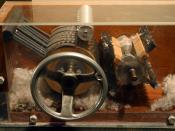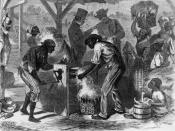From the beginning of American history, slavery always had a part. Starting in 1619, seven years after tobacco was first planted in Jamestown, Virginia, the practice slavery was instated in America (Berlin). Since then, slavery was incorporated into almost every aspect of American society, mainly agriculture. With tobacco being the main cash crop of America until the late eighteenth century, slaves were heavily relied on to sustain the tobacco economy in the Chesapeake region. When tobacco prices heavily dropped, the need for slaves dropped with it to a point where Virginia leaders even talked of abolishing slavery (ushistory.org). The talk of abolishing slavery ended when cotton first became a cash crop in the late eighteenth-century and sugar in the mid nineteenth-century and the need for slaves skyrocketed. This was all possible due to the invention of the cotton gin by Eli Whitney, and the vacuum evaporator by Norbert Rillieux.
The innovations by these two men changed the course of history "saving" slavery in the western hemisphere.
Until the invention of the cotton gin and the vacuum evaporator, cotton and sugar were not considered profitable businesses. Before the late eighteenth-century, cotton was mainly used only by the rich in Europe. This was due to the fact that cotton was an extremely troublesome crop as fibers of the cotton could only be separated from its pasty, implanted seeds by hand. This was a slow, grueling, and inefficient process that was not an economically sound investment (Woods). With such a large amount of work needed, it was said that "a shoe full of lint was a good night's work for any one person". Cotton being so expensive to produce, many turned to raising flax and wool before the invention of the cotton gin (Wynveen). Just like the production of cotton, sugar was...


